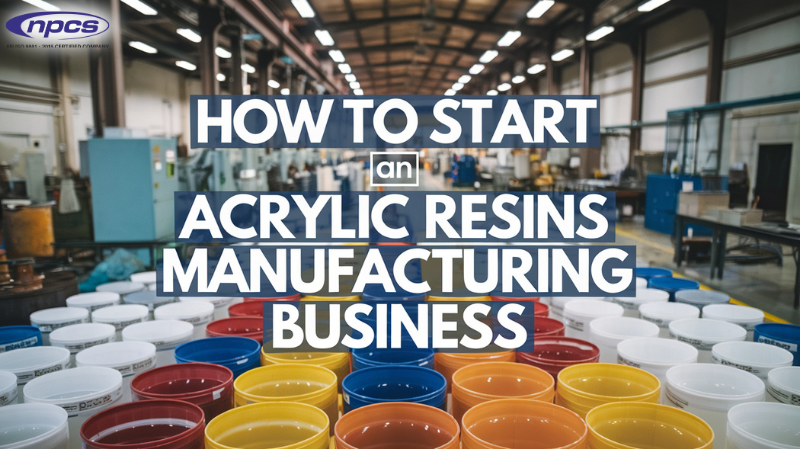Manufacturers use acrylic resins in a wide variety of applications, ranging from automotive, construction, adhesives, coatings, etc. Numerous factors, such as durability and clarity, support this choice. Manufacturers prefer acrylic resins because they can withstand the majority of climatic conditions. This book acts as a compass when you launch your business. It helps you identify target audiences and conduct market research. A thorough understanding of geography enables proper corporate placement. The handbook includes details on the product and insights into the production process. Best industry practices ensure efficiency and quality standards. You can establish a profitable acrylic resins business by following these steps.
What Are Acrylic Resins?
Acrylic resin is a specific class of polymer that may be thermoplastic or thermosetting composed mainly of acrylic acids and methacrylic. These are glassy transparent and weather-resistant polymeric substances that can be readily shaped or cast into desired forms. A widely used form is polymethyl methacrylate (PMMA) which finds application in glass substitutes, signage and light fittings, and coatings and adhesives among others.
Why Start an Acrylic Resins Manufacturing Business?
There are several factors that make prospects on investing in acrylic resins worth it.
- Boosting Demand: The acrylic resins’ market is expected to grow mainly due to structural coatings for automotive, construction and household products. In tandem with progression of industries, there will be an increasing need for quality acrylic resins.
- Broad range of Uses: There are many application sectors involving acrylic resins such as paint, lacquer, bacteria plastic, car interior and body devices, and medical equipment. Hence it is indispensable to many industries.
- Evergreen And Sustainable Opportunities: In recent times, as society is habitual of eco-friendly products, there are more markets for bio-based acrylic resin. There is room to invent and create environmentally friendly acrylic raw materials, such as bioresin and recyclables, for producers willing and able to serve a percentage of the market that is ecology-aware.
- Export Potential: Acrylic resins trade globally, which creates the opportunity of exporting your products to foreign markets. This can help extend the coverage and the profitability of your business.
Join Us : Niir Projects Consultancy Services
Niir Projects Consultancy Services
Benefits of Starting an Acrylic Resins Business
- Varied Market: There are various industries that require acrylic resins which makes the acrylic resins market broad and hence allows you to have different sources of income.
- Top Notch Resins: Provided that the right methods are applied in production, quality acrylic resins that are accepted within the industries can be produced which will help get and retain customers.
- Cost Constraints: The manufacturing of acrylic resins can begin from a very modest level that one can afford and one can build up over time as the sales begin to grow.
- Staying Power: The advancement in the application and formulation of acrylic resin is progressive therefore allows for room for creativity which gives you an advantage from your rivals.
Top Applications of Acrylic Resins
There are many industries where high performance acrylic resins can be applied include the following:
- Coatings: Acrylic resins have found their place in paints and coatings that need to be hard and glossy and these include automotive, industrial and decorative coatings.
- Adhesives: Manufacturers incorporate acrylic resins in adhesives to deliver strong bonds to different surfaces.
- Optical: Manufacturers mold optical acrylic resins, mainly PMMA, into finished lenses and eyeglasses, due to their light weight and transparency.
- Construction: Builders apply acrylic resins in solid surface acrylic materials and glazing systems to enhance aesthetics and longevity.
- Healthcare: Medical device manufacturers use acrylic resins in a rigid, transparent, and biocompatible formulation to create medical devices such as implants and laboratory wear.
Production Methods
The formulation of acrylic resins includes several high level operations that are as follows:
- Supplies
The production of acrylic resins begins with sourcing key raw materials, primarily acrylic and methacrylic acids, as well as various catalysts and additives.
- Polymerization Process
The primary method for producing acrylic resins is through the process of polymerization. There can be bulk, solution, emulsion or suspension method of polymerization. The selected polymerization method influences the properties of the end product.
- Purification and Formulation
After polymerization, the acrylic resins may require some purification steps aimed at the elimination of unreacted monomers and catalysts. The formulation stage is where other necessary additives aimed at modifying particular properties such as UV resistance, flexibility or adhesion are added.
- Quality Control
Typical measures of quality control also can be employed at the end of the production period pointing out that at every stage of production the molded articles should meet specific requirements. For example viscosity testing, clarity testing and testing of other physical properties.
- Cooling and Storage
After the final production step, the obtained acrylic resins should be cooled down and lodged for storage in proper containers to prevent loss of quality prior to their shipment.
- Safety Measures
Since this entails the use of materials that are chemical in nature, the process should also observe safety standards by for instance having a well-ventilated area and providing personal protective equipment as well employing a surveillance system to monitor the area.
Feasibility reports on: Soda Ash
Essential Machinery for Acrylic Resins Manufacturing
Acrylic resins are produced through the use of certain machines for effective and safe production. Some of the major components are:
- Polymerization Reactors
Polymerization reactors contain in them the capability of performing a polymerization reaction under a controlled temperature and pressure environment.
- Mixing Tanks
Mixing tanks are equipment meant for the mixing of these resins and therefore help in the achievability of the intended proportions of the raw materials.
- Cooling Systems
The cooling systems are utilized to control the temperature during the polymerization reaction and also to cool the polymer either before packing or storage.
- Storage Tanks
Some of the containers needed are those that are used to contain unprocessed materials and processed acrylic materials to prevent their contamination.
- Quality Control Equipment
Acquire the machines used to measure the mechanical and chemical properties of acrylic resins and assure compliance with the production standards of these resins.
- Safety Equipment
Some of the recommended gear for protection include fire fighting equipment, emergency showers, and even protective clothing for workers who come into contact with dangerous substances.
Starting Your Acrylic Resins Manufacturing Business
To Launch the Business that Produces Acrylic Resins Successfully, Eliminate the Following Hurdles:
Conduct Market Research
It is of utmost importance to have a good grip of the market dynamics. Look for those who may buy twelve resins such as automotive manufacturers, construction applications, and even consumer goods producers. Evaluate the competition and potential trends that your products can leverage to drive increased sales.
Develop a Business Plan
A business plan with specific targets for production, marketing, finance and operations is necessary. This will not only be required to run the business but also help in bringing in investors.
Regulatory Approvals Are Needed In Most Cases
The very nature of the chemicals used in making acrylic resins can be hazardous, thus the need to follow the local and global regulations. Obtain all the required consents and licenses from the environmental and health occupational departments.
Set Up the Plant
Use the appropriate materials to construct the manufacturing plant and create the required machinery within it. Purchase ventilation systems, fire extinguishing systems and others to assist with compliance.
Procurement of Materials
Identify and procure a continuous source for essential materials namely acrylic acids and their various additives. Create a lasting material supply bond with supplier entities by entering long term agreements.
Quality Management System
Ensure implementation of the quality control procedures throughout the entire production cycle. Maintain routine assessment of the raw materials and finished goods.
Sales and Marketing Activities
Create a promotional strategy that would involve direct marketing, attendance at conferences, and online marketing to attract prospective clients. Underscore the advantages of your acrylic resins and particularly their quality and versatility.
Invest in Research & Development
More funds should also be allocated to R&D to help ensure that the business does not get left behind and instead enhances the products on offer. Investigate alternative uses and new compositions of acrylic resins in response to changing consumer needs.
Conclusion
For entrepreneurs, beginning a business specializing in the manufacture of acrylic resins is likely to be a good business opportunity. Because of its myriad uses and ever-expanding market, the chances for success are quite great. Businesses must follow certain measures in this industry to ensure profitability – from knowing what customers want to maintaining all required standards.
To sustain any business, owners must employ innovativeness, observe the market keenly, and provide quality control measures. The growing demand for raw materials such as acrylic resins and various business strategies in place offer opportunities to take advantage of such markets and contribute to the growth of the chemical sector. When well planned and executed, starting an acrylic resin plant gives one the chance to run a profitable business enterprise.






